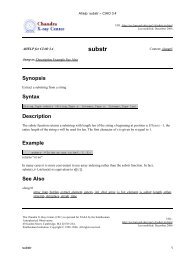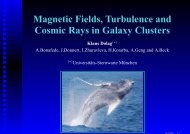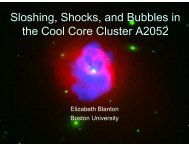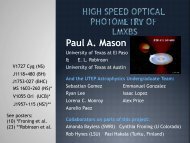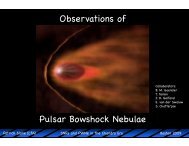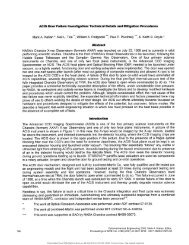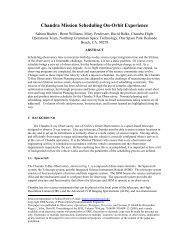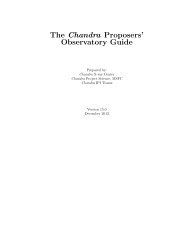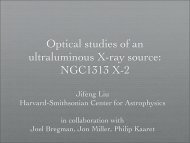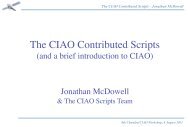PDF Version - Chandra X-Ray Observatory (CXC)
PDF Version - Chandra X-Ray Observatory (CXC)
PDF Version - Chandra X-Ray Observatory (CXC)
Create successful ePaper yourself
Turn your PDF publications into a flip-book with our unique Google optimized e-Paper software.
Spring, 2012<br />
(Fig.1) allow users to adjust the layout of their plots and<br />
make edits to many of the plot properties. A Python terminal<br />
is built into the GUI, allowing access to ChIPS and other<br />
Python commands. The GUI is available to any process that<br />
creates a ChIPS plot, such as Sherpa and Prism. It can be<br />
launched by right-clicking on on an existing ChIPS window<br />
and selecting “Show GUI”, or by running the show_gui<br />
command from the ChIPS command line. Currently the<br />
GUI allows users to edit the properties of existing visualizations<br />
but does not provide the ability to add or create new<br />
objects.<br />
A large gallery of ChIPS examples is included in<br />
the ChIPS website at http://cxc.harvard.edu/chips/gallery/<br />
and there are a number of introductory threads to guide<br />
beginners.<br />
SHERPA<br />
Sherpa (http://cxc.harvard.edu/sherpa/) is the<br />
modeling and fitting application within CIAO that can be<br />
used for analysis of images, spectra and time series from<br />
many telescopes, including optical telescopes such as Hubble.<br />
Sherpa is flexible, modular and extensible. It has an<br />
IPython user interface and is also an importable Python<br />
module. Sherpa models, optimization and statistical functions<br />
are available via both C++ and Python for software<br />
developers wishing to link such functions directly to their<br />
own compiled code. Important changes and additions to<br />
the Sherpa functionality in the CIAO 4.4 release are described<br />
in a dedicated webpage at http://cxc.harvard.edu/<br />
sherpa/updates.html Among the several improvements to<br />
the software, we highlight two advanced features below.<br />
Bayesian Analysis with pyBLoCXS<br />
pyBLoCXS, a sophisticated Markov chain Monte<br />
Carlo based algorithm designed to carry out Bayesian Low-<br />
Count X-ray Spectral (BLoCXS, van Dyk, et al. 2001) analysis<br />
in the Sherpa environment, is available via several new<br />
Sherpa functions. The algorithm explores parameter space<br />
at a suspected minimum, using a predefined Sherpa model<br />
applied to high-energy X-ray spectral data. pyBLoCXS<br />
supports the ability to flexibly define priors and allows for<br />
variations in the calibration information. It can be used to<br />
compute posterior predictive p-values for the likelihood ratio<br />
test (Protassov et al. 2002) .<br />
Template Models<br />
Sherpa supports a new template model (an extension<br />
of the table model). Sherpa can now read in a collection<br />
of templates from a directory full of template files, and<br />
can compare a data set to all the templates in that collection.<br />
Sherpa finds the template that best matches the data,<br />
and reports back the parameter values associated with that<br />
21<br />
template. The gridsearch optimization method will select<br />
the best template model by trying all of the templates. This<br />
method evaluates the fit statistic for each point in the parameter<br />
space grid; the best match is the grid point with<br />
the lowest value of the fit statistic. Gridsearch reports back<br />
the parameter values associated with this point. The Sherpa<br />
template model supports nearest-neighbor and polynomial<br />
interpolation.<br />
Users interested in hands-on CIAO training should<br />
plan to attend a future CIAO workshop at the <strong>Chandra</strong> X-<br />
<strong>Ray</strong> Center. More information will be posted at http://cxc.<br />
harvard.edu/ciao/workshop/ when available.<br />
More information and updates on CIAO can always<br />
be found at http://cxc.harvard.edu/ciao/ or subscribe<br />
to the CIAO News RSS feed at http://cxc.harvard.edu/ciao/<br />
feed.xml<br />
To keep up-to-date with CIAO news and developments<br />
subscribe to chandra-users@head.cfa.harvard.edu<br />
(send e-mail to ‘majordomo@head.cfa.harvard.edu’, and<br />
put ‘subscribe chandra-users’ (without quotation marks)<br />
in the body of the message).<br />
References<br />
Protassov, R., van Dyk, D.A., Connors, A., Kashyap, V.L., Siemiginowska,<br />
A. (2002). ApJ 571:545.<br />
van Dyk, D.A., Connors, A., Kashyap, V.L., & Siemiginowska, A.<br />
(2001). ApJ 548:224.<br />
The Results of the<br />
Cycle 13 Peer Review<br />
Belinda Wilkes<br />
The observations approved for <strong>Chandra</strong>’s 13th observing<br />
cycle are now in full swing and the Cycle 14 Call for Proposals<br />
(CfP) was released on 15 December 2011. Cycle 12<br />
observations are close to completion.<br />
The Cycle 13 observing and research program was<br />
selected as usual, following the recommendations of the<br />
peer review panels. The peer review was held 21–24 June<br />
2011 at the Hilton Boston Logan Airport. More than 100<br />
reviewers from all over the world attended the review, sitting<br />
on 15 panels to discuss 664 submitted proposals (Fig.<br />
1). The Target Lists and Schedules area of our website provides<br />
lists of the various types of approved programs, including<br />
abstracts. The peer review panel organization is<br />
shown in Table 1.



